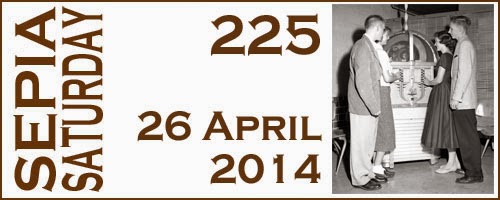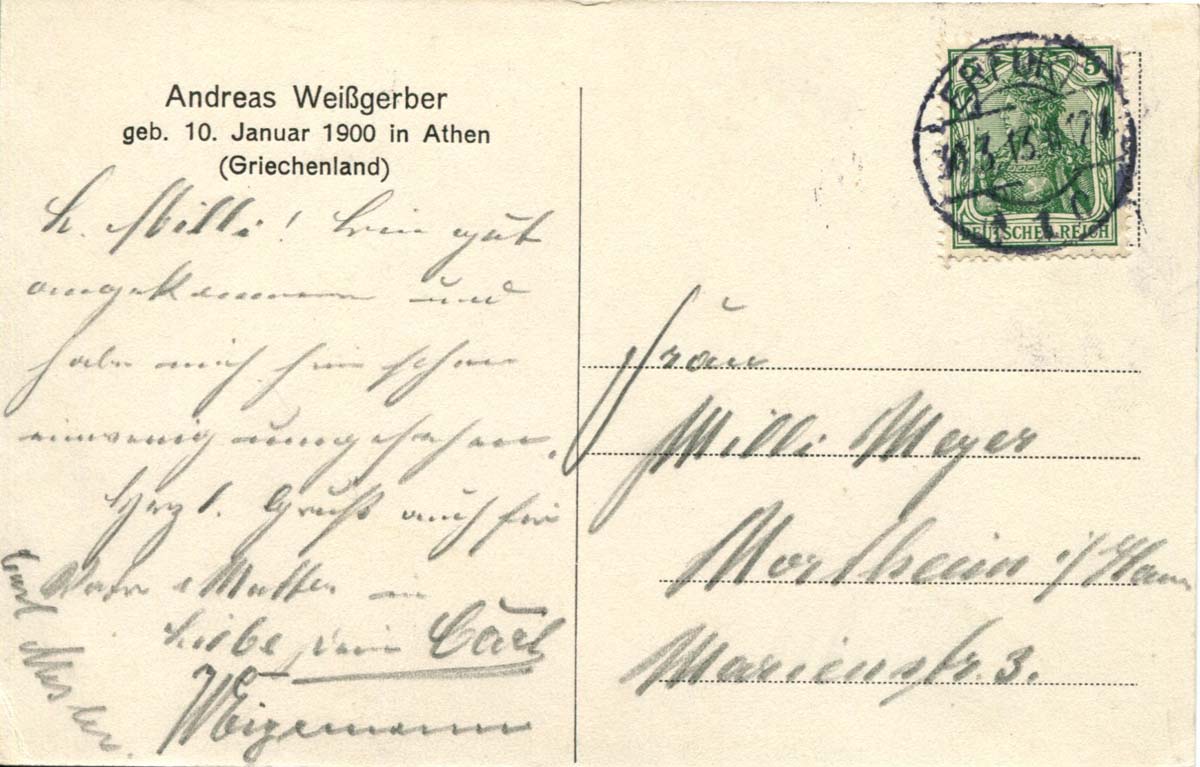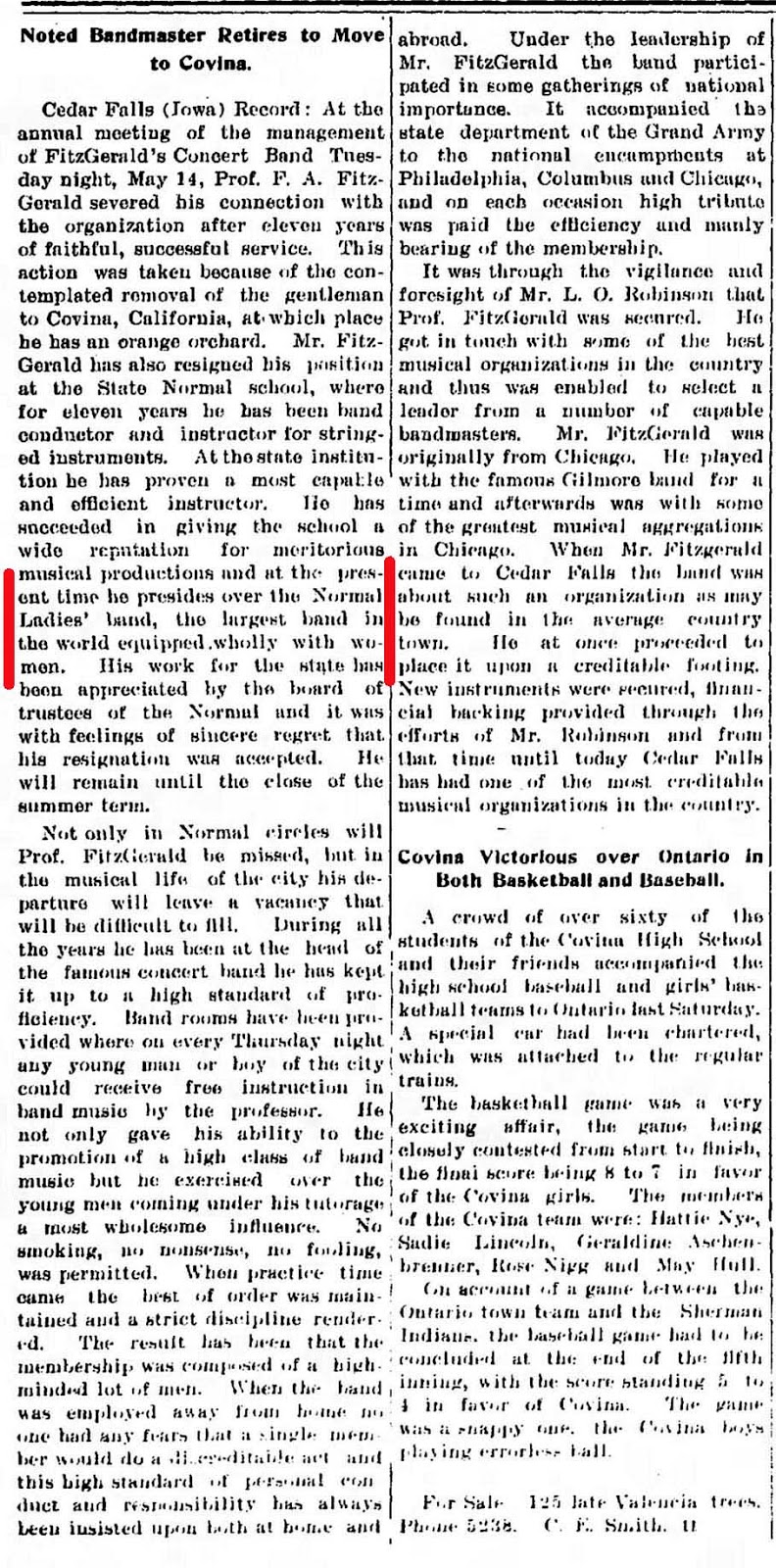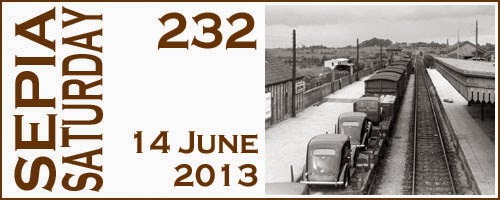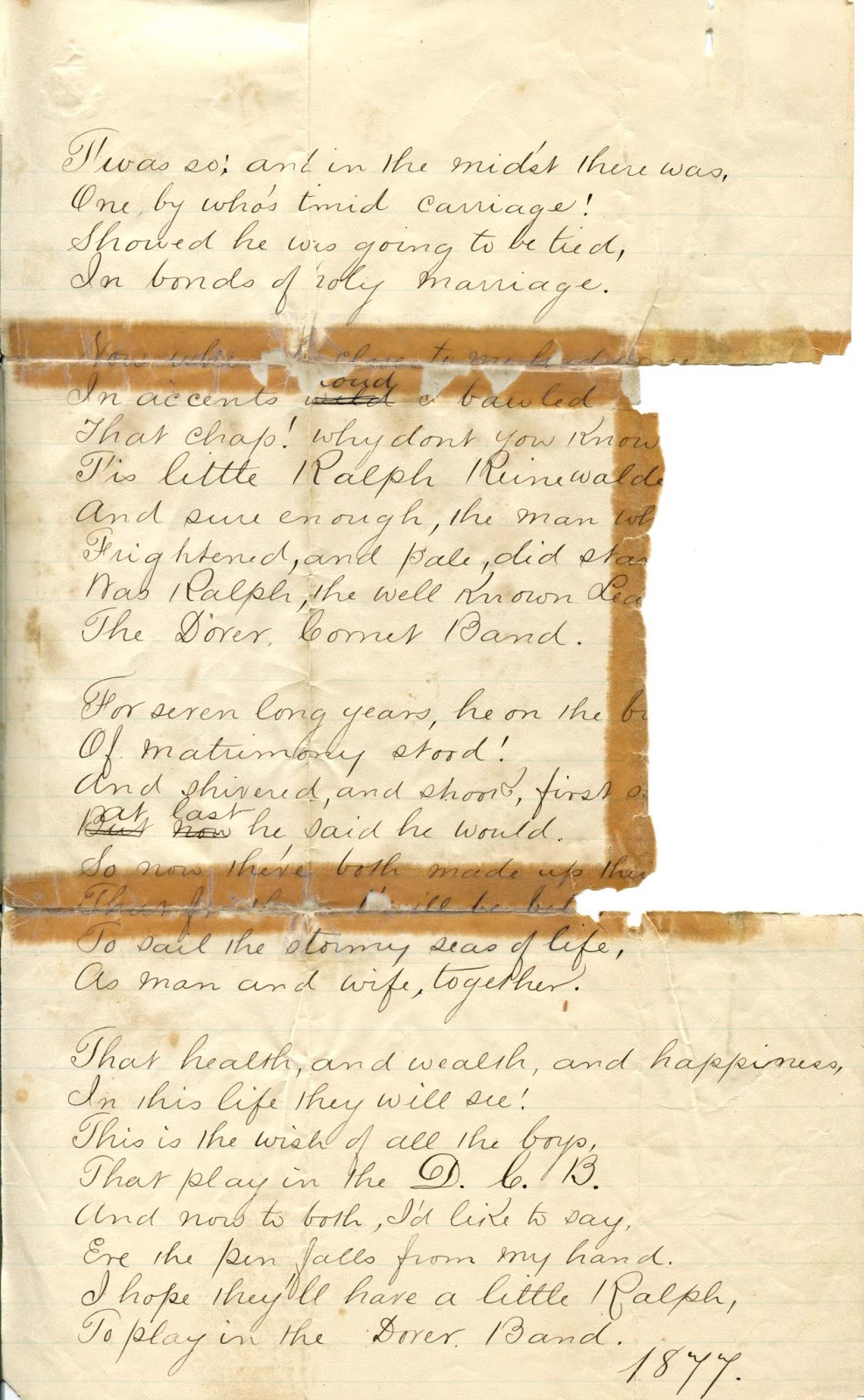This is a photograph of a workshop. There are tools, a bench, even a cabinet to hold construction plans. It is a place where a craftsman makes things requiring skill and art. It is a musician's studio. Specifically it is the music room of Miss Winifred Sylvester– her "den". It may look like an occupational still life with instruments, but in fact there are many people here that Winifred would like us to meet.
The foreground is dominated by the side of a grand piano. Behind it along the wall are two violins, two larger violas, and a small parlor-size guitar. Violin bows are propped against the instruments as if to be ready for any moment's inspiration. I suspect that Winifred is standing beside the photographer's camera and checking the arrangement. The many instruments argue that she was a very talented musician. It is her special space and around the walls are framed paintings and photos for us to admire.
This cabinet photograph has no imprint of a photographer's name. However it is nicely signed on the back.
My "Den" 16 Melbury Rd
Kensington
Winifred Sylvester 1895
Kensington
Winifred Sylvester 1895
Winifred was born in 1877 in Bombay, India, the only daughter of Matilda and John Henry Sylvester. She was only 18 when she inscribed this photo. Her father John was a surgeon and doctor of medicine assigned to a cavalry regiment in the British Indian army. After his military service in India he brought his family to live at No.16 Melbury Road in Kensington, London.
We will meet the Sylvester family another time. Today the story is about Winifred's musical friends and since there are quite a few people to be introduced, let's begin with the most prominent.
Just above Winifred's violas and violins hangs a large framed portrait of man with an impressive brush of a mustache. The picture is swathed in fabric that initially I mistook for the black drapery of mourning. However this gentleman was very much alive in 1895. A slightly smaller etching of him with his violin is tucked behind the frame on the right.
He is one of the greatest violinists of the 19th century, or indeed of all time. He is Pablo de Sarasate (1844 - 1908), or as his friends used to call him — Pablo Martín Melitón de Sarasate y Navascués.
 |
| Pablo de Sarasate (1844 - 1908) Source: Wikipedia |
Born in Pamplona, Spain in 1844, Sarasate's father was a bandmaster of a military band. As a child, Pablo was recognized as a prodigy on the violin and gave his first public concert at age 8. He would go on to become one of the most successful violin virtuosos of his time, performing in every major concert hall around the world, including regular recitals in London. His fantastic skill was displayed in incredibly difficult pieces that he composed or arranged himself. Many of today's violin superstars play these same pieces.
As he lived into the era of sound recordings, we can listen to him play. This YouTube video has Pablo Sarasate himself performing his best known encore for piano and violin, Zigeunerweisen (1878) based on Hungarian gypsy melodies. The recording was made in Paris in 1904 and I recommend it as the perfect accompaniment for reading the rest of the story. Just before the Allegro you can even hear his voice.
>>> <<<
>>> <<<
The front of the piano lid has been flipped over and the polished surface is shiny enough to reflect this framed portrait of another man with a distinctive hair style.
It is Ignacy Jan Paderewski, (1860 - 1941) the great Polish pianist and composer.
 |
| Ignacy Jan Paderewski (1860 - 1941) Source: Wikipedia |
Paderewski was also a musically gifted child but his talent took longer to mature as it developed in the Warsaw conservatory and then private study in Berlin and Vienna. But after his debut in Vienna in 1887 his name soon became synonymous with piano virtuosity. Like Sarasate, he gained fame as a brilliant pianist by touring the world. He was a frequent concert artist on the stages of London.
On the other side of the room is another of portrait of Paderewski displayed on the music cabinet. It sits on a small easel festooned with decorative fabric and flowers.
His flamboyant hair is unmistakable but sepia tone photos fail to pick out the red color. Though he was by no means the only musician to fashion his celebrity image around a hairstyle, in the 1890s he was the best known performer of "long-hair" music.
 |
Ignacy Jan Paderewski (1860 - 1941) Source: Wikipedia |
Paderewski was living at a time when travel and technology freed artists from the dependency of wealthy patronage which earlier composers like Mozart and Beethoven had needed for survival. But success only came after building a fan base and that meant posing for the camera. Many musicians produced for themselves or licensed photos to be produced for sale as souvenirs. Unlike violinists who can easily pose with their instrument, pianists were rarely pictured at the piano.
Music was not Paderewski's only passion. His place in history was enshrined by his great love for his country of Poland. During the First World War he was a member of the Polish National Committee in Paris, and became a important political activist advocating for the establishment of Poland as a free independent nation. In honor of his tireless efforts and international prestige, he was made Poland's first Prime Minister in 1919, but the hard knock life of politics became too difficult and he left it in 1922 to return to concertizing on the piano.
>>> <<<
Next to Paderewski's second portrait is a small image of a man holding a violin. He appears to have a beard too.
In the 19th century, even this blurry figure would be instantly recognized as a superstar musician. His name is Joseph Joachim (1831 - 1907), a Hungarian violinist who knew all of the famous composers of his time. He too was acclaimed as a musical wunderkind violinist when his early musical training took him to Leipzig to become a protégé of Felix Mendelssohn.
For a time Joachim was concertmaster in Leipzig under Franz Liszt's music directorship. He was a good friend of Robert and Clara Schumann. But it was his close personal relationship with Johannes Brahms that placed his name in music history. Brahms's Violin Concerto, and Double Concerto for violin and cello were written for Joseph Joachim.
 |
| Joseph Joachim (1831 - 1907) |
There were a number of photographs made of Joachim, and this one matches the blurred image in Winifred's music room. It was made around 1885 when Joachim was in his 50s. Though he was also a composer like Sarasate and Paderewski, his own music is little known today.
His primary influence came as a violin soloist playing other composers' music. But he is also remembered in the genre of chamber music when his Joachim String Quartet achieved major prominence with world tours. He brought this group to London many times, and it may be how Winifred Sylvester first heard him play, rather than as a soloist with an orchestra.
Joseph Joachim also lived long enough to produce a solo violin sound recording. In fact he was the first, with a disc made one year earlier than Sarasate. This is his arrangement of the Brahms Hungarian Dance No.1, recorded in Berlin in 1903.
>>> <<<
>>> <<<
Just to the right of Joachims photograph is another unclear image. We can see that it is a woman, but only someone like myself who sits at the back of the orchestra would recognize the silhouette of a violinist's backside.
This musician is definitely someone that a young girl like Winifred would idolize. The violinist in the photo is
Wilma Neruda, (1838 - 1911) also known as Lady Hallé. She was the most famous female musician of the Victorian era, and was a frequent soloist with British orchestras.

The unclear image matches a copy of a photo of Lady Hallé produced in the 1880s. She was born in 1838 in Brno, Moravia, which was then part of the Austrian Empire. It was a musical family as her father was the organist of the cathedral at Brno. In those days, a violin was not considered a proper instrument for a girl, so Wilma's first music instruction was on the piano. After she was discovered secretly playing her brother's violin, she was allowed to develop her true talent. Her first concert was at the age of 7 performing a Bach violin sonata.
In 1865 Wilma Neruda married a Swedish pianist Ludvig Norman (1831–1885) who was also a composer and conductor. When Norman died in 1885, she had already been living and performing in London. Just a few years later she married the Anglo-German musician Charles Hallé, noted as a pianist, conductor and the founder of Manchester's The Hallé orchestra in 1858. He was given a knighthood for his service to British music in 1888, and thus she took on the name Lady Hallé.
 |
| Wilma Neruda, Lady Hallé (1838 - 1911) Postcard photograph by Bassano, London, c.1885 Source: momh.org.uk |
In this age, women had very few avenues to follow for a career in the musical arts. Professional orchestras did not accept women as members, but they would accompany female soloists of the respectable "feminine" instruments – piano, voice, harp, and violin. Lady Hallé had a musical talent and ambitious drive that made her the most visible woman instrumentalist on the concert stages of Europe. By 1901, she had attained such international esteem that Queen Alexandra, consort of King Edward VII, appointed her violinist to the Queen. One can easily imagine how such an artist would inspire a young woman like Winifred Sylvester.
In 1893, the Monthly Musical Record, a London magazine, reported that Dr. Joachim and Lady Hallé performed Bach's Double Concerto at a Saturday concert series at St. James Hall. The audience was described as larger than any previous in the season and demanded an encore of the slow movement. In the same edition were numerous reviews of Pablo Sarasate who also had his own regular concert series at St. James Hall. Likewise Paderewski performed there in 1892 and 1893 too.
A review of an 1895 concert of Joachim found in the Saturday Review of Politics, Literature, Science and Art, Volume 79, page 315 included a mention of both Sarasate and Lady Hallé. Since this was the same year as when Winifred Sylvester made a photograph of her music studio, it's quite possible she attended the concert. I don't know the author of this review, but it is a marvelous example of damning with faint praise.
All Joachim's many shortcomings we cheerfully admit; and then we assert that the man does play at times so as almost to warrant the most encomiastic things said of him by critics of his own race. There are people who have heard him many times and declare that never in their experience did he play well; but for our part we rarely sit through a Joachim concert without ultimately receiving our reward in at least one spell of inspired interpretation. The waiting is often long and dreary, for he is no great fiddler who can cover the weakness of his uninspired moments by wonderful technical displays or uniformly lovely tone: he is no great fiddler, but rather a consummate interpretative musician who fiddles; and when the execution does not come up to his conception he makes matters worse by forcing the pace and thrashing his strings until the jarring sense discord reaches the limits of what human nerves can endure.
Then unexpectedly the moment arrives, he slips into the right groove, his better genius seems take the bow from his right hand and control the fingers of his left, and the tones come from his violin magnificently strong — not glowing in voluptuous splendour like Sarasate's, nor with the purity of Lady Halle's — but throbbing, alive, with something human in their accent that reminds one that, after all, Joachim has always aimed high and sought to get essential qualities of the human voice into his playing. All exaggeration melts away; the player's technique masterful, his phrasing strong and lucid, his florid passages clean cut, even his intonation fairly true.
But these points we remember later; at the time we are conscious only of the high gift of expression which Joachim sole amongst modern violinists possesses: the of voicing not the player's but the composer's emotions. Not only is the dramatic accent true, but the tone colour, the "clang tint", is astonishingly appropriate. In the delivery of the "Death and the Maiden' theme in the Schubert quartet played on 25 February (1895) the tone was tragic sinister; in the major variation, which Schubert's way of singing "Surely he takes his fill, Of deep and liquid rest", and thus he ever varies it, when the mood is on him, using only to the finest ends the wonderful capabilities of the violin which lesser men prostitute when they make their instruments crow like cocks, cackle like geese, or shriek unholy dances for witches to dance to.
To come to an end then: only in his inspired moments is revealed the incomparable artist, the Joachim who is worth admiration; as for the fellow who plays with Bach, takes Beethoven skittishly, and insists upon wearying us with tedious Brahms sonatas, he is a commonplace, rather unskilful mechanic, unfortunately sometimes a pretentious mechanic.
>>> <<<
 |
| Wolfgang Amadeus Mozart (1756-1791) photograph by Frd. Bruckmann of painting by Carl Jäger Source: BNF.fr |
Just to the right of Sarasate's picture are two drawings or etching of composers. The one on the left might be Mozart as it looks like a man wearing a baroque period wig, but it may be a woman's picture. There is too much glare to be sure.
This etching of Wolfgang Amadeus Mozart by the German artist, Carl Jäger (1833-1887) seems very similar to Winifred's picture.
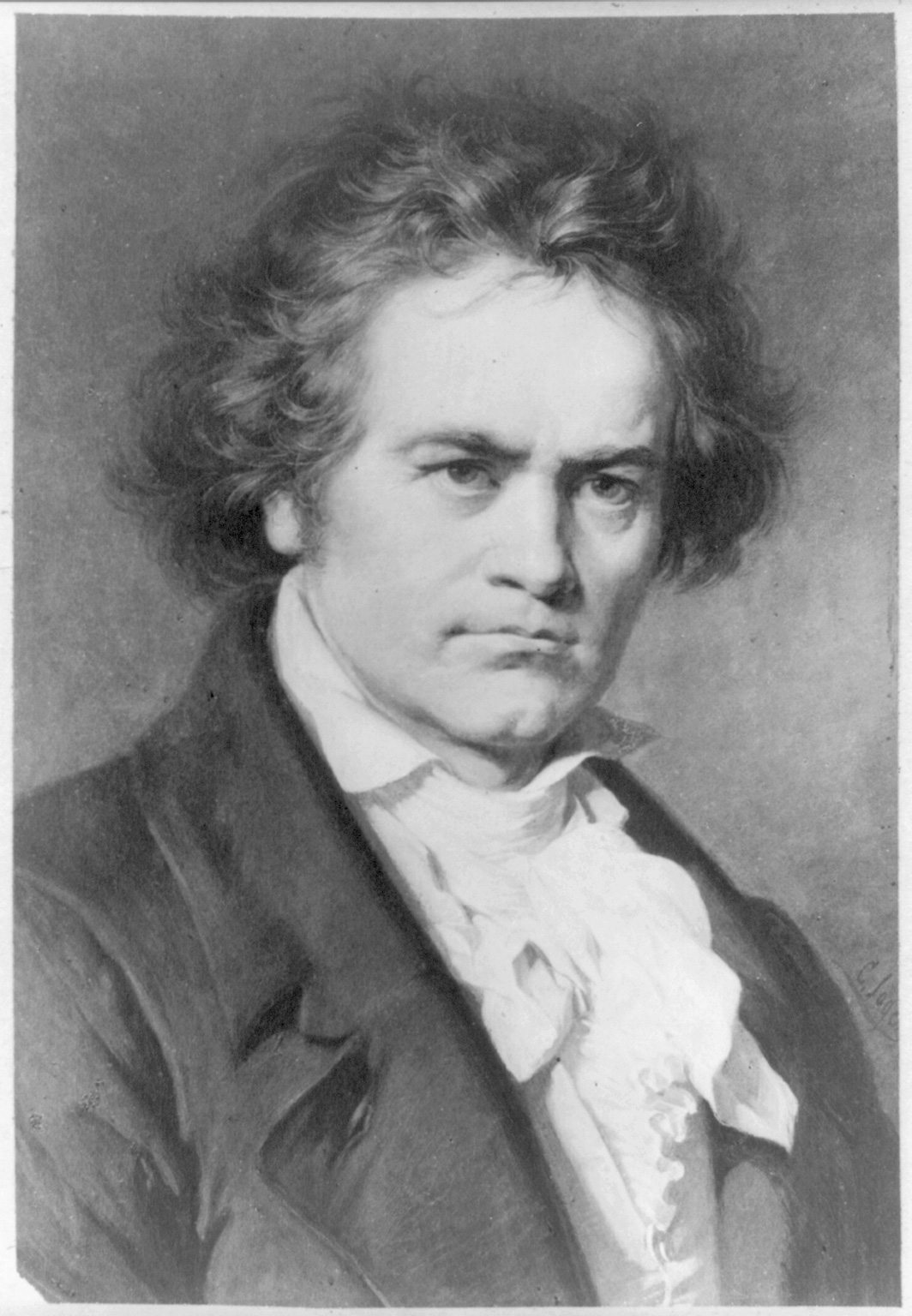 |
| Ludwig van Beethoven (1770 - 1827) Painting by Carl Jäger (1833-1887) Source: Wikipedia |
However the other one is definitely the glowering face of Ludwig van Beethoven, (1770 - 1827) who of course died before the advent of daguerreotype photography. Consequently like Mozart, he is represented only in drawings and paintings, of which there are thousands, and every one shows him with a grumpy frown. This etching of Beethoven, also by Carl Jäger, shows the typical Romantic period interpretation of the composer.
By 1895 music was no longer based on what living composers wrote, as it had been in the time of Mozart and Beethoven. Music publishing had become a big business that enabled any musician anywhere to study the music of composers from any earlier era. Winifred probably had editions of the collected works of Bach, Handel, Haydn, Mozart, Beethoven in her music cabinet. This would have been unheard of only a few decades earlier.
>>> <<<
But the most important picture is the one just under Beethoven in a small gilt frame. It is another picture of a man with a violin. It is the reason I acquired the photo of Winifred's music room.
Sometime ago a set of estate photos was put up for auction. On close examination, I found one photo inside another. It was so unusual I could not allow them to be separated, so I bought both.
This photo within a photo is Winifred's most prized memento, "her master", Josef Ludwig.
Across the front is an inscription in ink. It reads:
Yours very sincerely
Josef Ludwig
Josef Ludwig
In the detail of the music room photo, you can just see the faint marks of his handwriting.
Josef Ludwig was a German musician, born in Bonn in 1845. He was one of many German musicians who came to Britain during the reign of Queen Victoria, whose consort, Prince Albert, was from Saxe-Coburg in Germany. The first notices of Ludwig's concerts came from 1869. He became an annual favorite at the Bath Grand Pump Room concerts and played there until at least 1915. As a violinist he seems to have specialized in chamber music rather than orchestral music, as he is described as a soloist rather than a leader or concertmaster.
On the back of this cabinet photography by Walery, Photographer to the Queen, 184 Regent Street, London is a scrawl in red pencil.
My Master
In Italian the word is Maestro. Surely only Winifred could have written this of her violin teacher. I suspect that same red pencil drew many bowing marks onto her violin music.
Josef Ludwig was entered into the 1911 England census, age 66, widower, living with his daughter Christine Ludwig, age 38. His occupation was Professor of Music. His home was at No.10 Howley Place, London, which is only a short walk from the Royal Academy of Music and convenient to the many concert halls in central London. It is also only 2 miles from Melbury Rd. where Winifred Sylvester lived.
I never cease to be amazed at the resources available in the vast library of the internet. In the past I would never have contemplated that we could ever see Winifred's home, but through the magic of Google Maps we can take a virtual tour to No. 16 Melbury Rd., London W14.
>>><<<
>>> <<<
Today this narrow red brick house has been divided up into very expensive flats, but at one time in the 1890s a small family of three – father, mother, and daughter (plus a servant or two) called this home. Was Winifred's music den on the ground floor behind the bow windows? Or maybe higher? A piano is big, but it is not impossible to move one to the floor above.
This is a very beautiful and quiet section of London that is off of Kensington High St. and below Holland Park. When I first looked it up on a London map I was surprised at how close it was to the Leighton House, the extravagant residence of the great painter Frederic, Lord Leighton(1830-1896), who was an important artist of the English Pre-Raphaelite Brotherhood style. Many years ago I once performed a recital there at the Leighton House Museum when I lived in London and was studying the horn. At one time I might even have walked past No.16 Melbury Rd.
In the gigantic 1902 London Post Office directory, the residence names are also listed geographically by street name. Melbury Road is quite short with only 22 names for 18 numbered houses. Among those names are 8 men whose occupation is listed as artist. Five were members of the Royal Academy of Arts. (R.A.), as was Frederic Leighton. Winifred's neighbors turned out to be some of the most distinguished personages in the Victorian world of art. This was an extraordinary street even by London standards.
This unframed picture is propped up in the left corner of Winifred's studio. I believe it is a group of musicians as there are two violin shapes held by the figures far left and right. But the people are dressed in costume reminiscent of the Elizabethan or Renaissance periods. The English artists of the Pre-Raphaelite were very fond of painting historic subjects in elaborate dress and I believe this may be either a copy of a painting by one of Winifred's neighbors, or a photo of a group of models for such a painting.
 |
| Cimabue's Madonna Carried in Procession Frederic Leighton (1830-1896) Source: Wikipedia |
But there is one more picture on the wall of Winifred's studio that attracted my attention because it doesn't have a musical subject. Slipped behind the frame of Pablo Sarasate, is a curious image of a seated man. He appears elderly with a white beard and wears a black skull cap. Within the picture are even more paintings. Could this image be connected with one of the artists who lived on Melbury Road?
The internet provides the answer. Yes, this is Miss Sylvester's neighbor, George Frederic Watts (1817 - 1904) who lived at No.6 Melbury Rd.
 |
| George Frederic Watts (1817 - 1904) Source: National Portrait Gallery, London |
 |
| Hope, 1886 George Frederic Watts (1817 - 1904) Source: Wikipedia |
The sculpture and paintings of Watts were often allegorical in nature and had mythological subjects. His 1886 painting, entitled Hope, hangs in London's Tate Gallery. It shows a blindfolded female figure seated on a globe and plucking a lyre that has only one remaining string. Watts gave this explanation: "Hope need not mean expectancy. It suggests here rather the music which can come from the remaining chord".
This melancholy depiction of hope led the writer G. K. Chesterton to suggest that a better title would be Despair.
I would be remiss if I did not introduce you to
Miss Winifred Sylvester.
She is age 10 here, about the same year as when Mr. Watts was exhibiting his painting.
The collection of keepsakes in her music room would not be unusual for a girl from any decade. The posters hung on the bedroom wall of a modern teenager are not much different. Except that Winifred was not living in Kansas in 2014.
All of her musical heroes were in their prime as musical artists in 1895. Today they are renown as luminaries of 19th century music. Since it is highly likely that Winifred knew these famous musicians from hearing them perform in London, and may even have taken lessons from them, their presence in her music room helps describe a new powerful culture of concert musicians who precede the age of sound recordings. The beautiful music they made became the sound that filled a young girl's imagination and dreams.
If you return next weekend, I promise to make a proper introduction of Winifred and her parents at No.16 Melbury Rd. She has more stories to tell.
This is my contribution to Sepia Saturday
where everyone loves to sing along with the piano.
where everyone loves to sing along with the piano.



























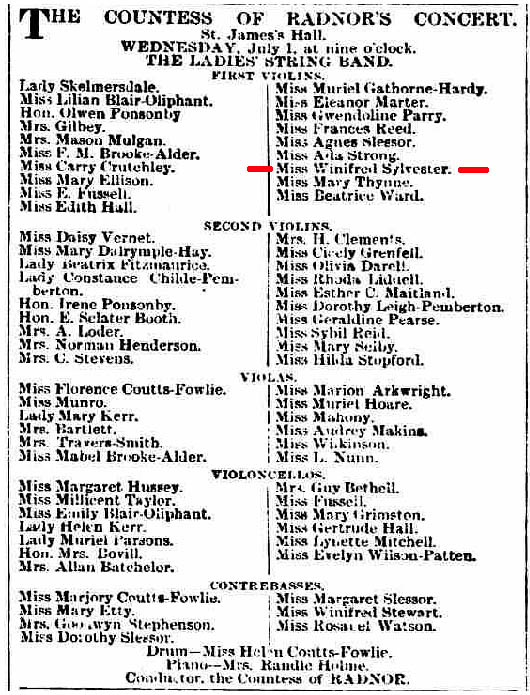
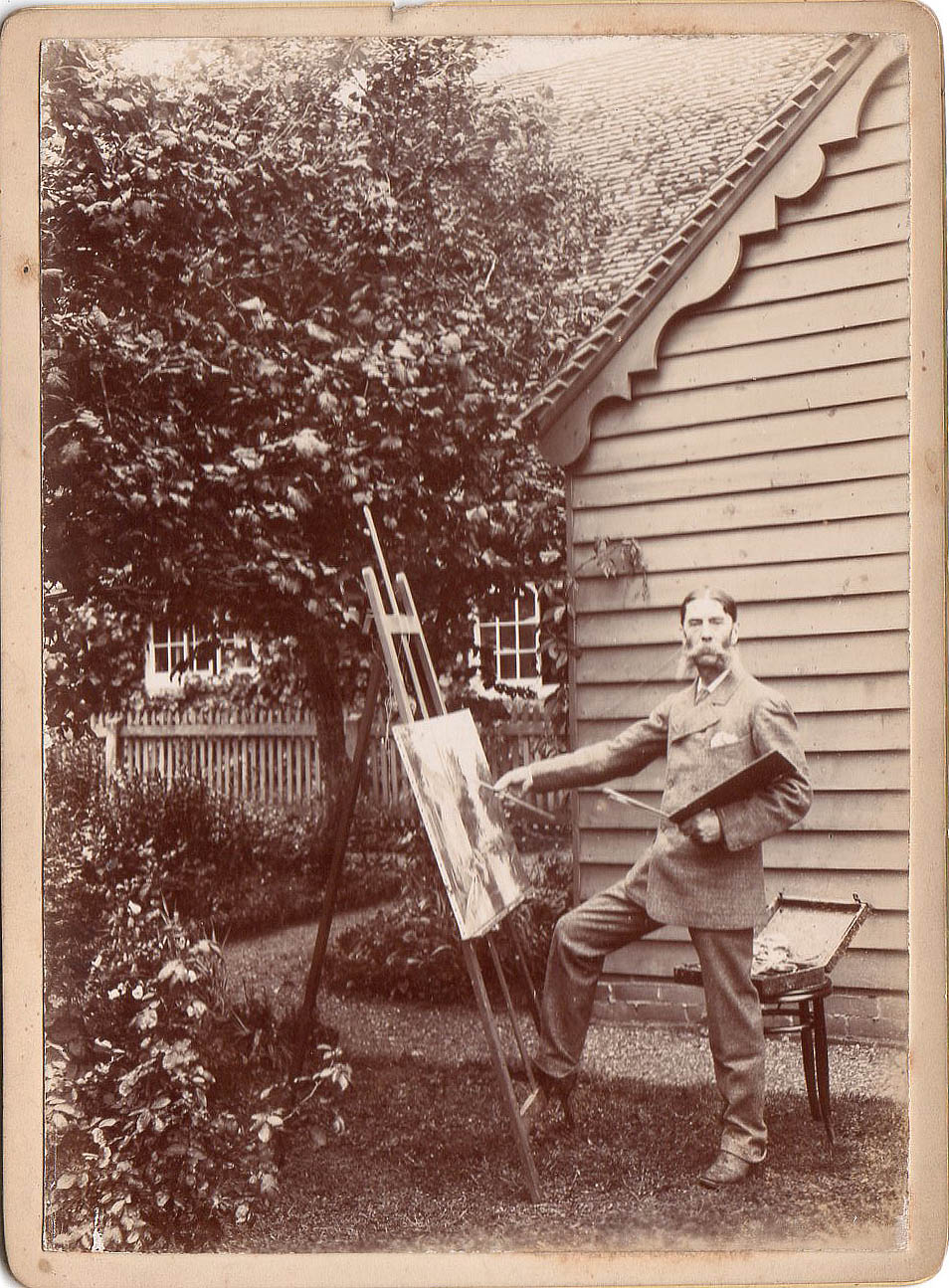




















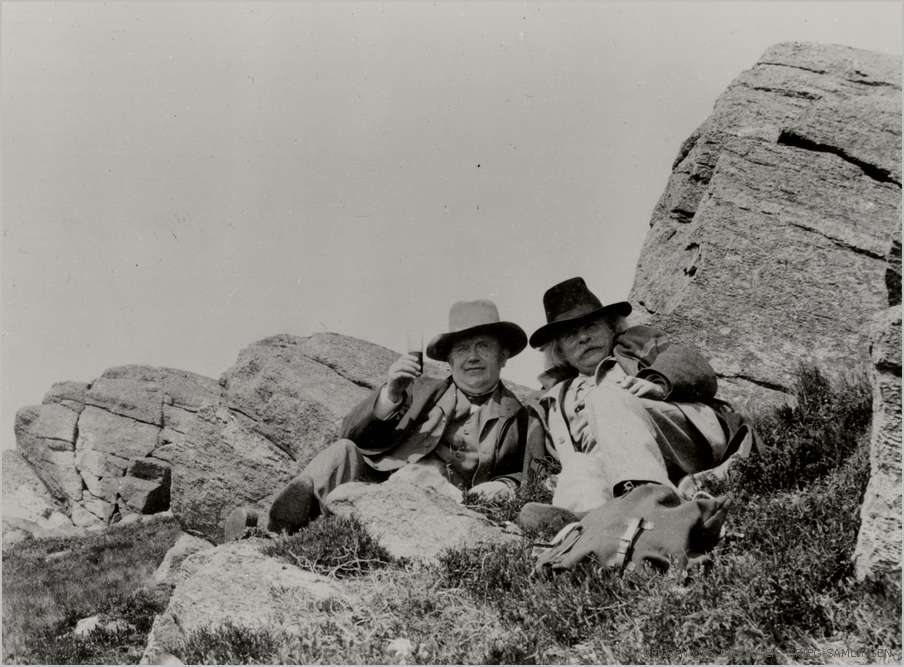









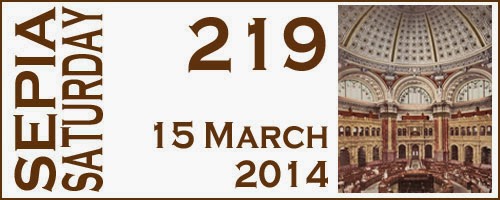






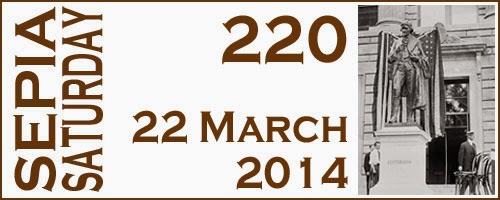

























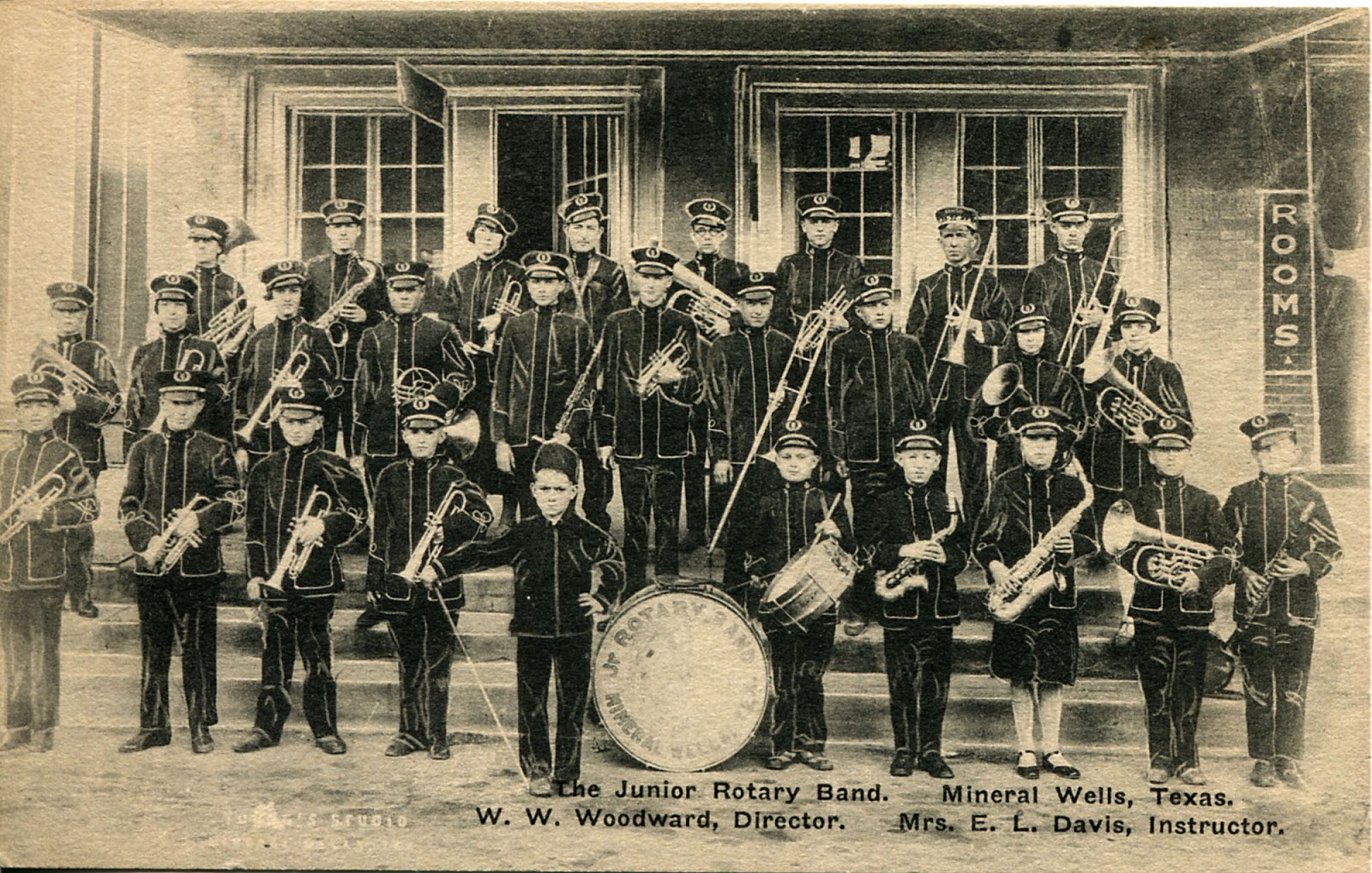


















 \
\

